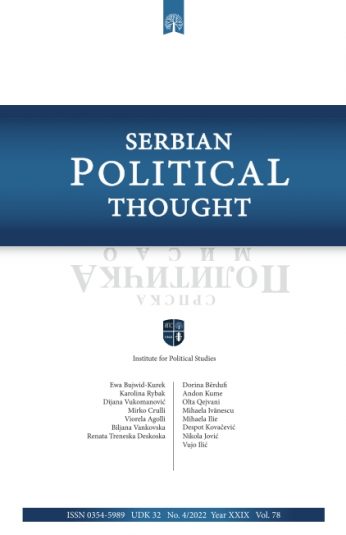Main topic
spt1/2013
New Regionalisms, Border Problems and Neighbouring policy: A Comparison Between Southeast Europe and East Asia
Abstract
Since the end of Cold War, what we call ‘new regionalisms’ has flourished in the world. In Europe, the process of EU enlargement has advanced to include former socialist countries of Eastern Europe. In East Asia there have emerged significant region-wide organizations: ASEAN expanded to include ten member states. In addition, the post-Cold War period witnessed the emergence of Asia Pacific Economic Cooperation (APEC), the ASEAN Regional Forum (ARF), ASEAN+3, and EAS (East Asia Summit) and so forth. However, it is often said that the institutionalization of political cooperation in East Asia has been much slower compared with that of Western Europe. This paper examines some main features of regionalism in Southeast Europe and East Asia from comparative perspective, referring to the meaning of the border problems in both regions and the neighbouring policy of Serbia and Japan.
References
- Anderson, J. (2001) “Border after 11 September 2001”, Space and Polity, 6(2): 227-232.
- Avery, E. C. (2008) “North Korea’s Abduction of Japanese Citizens and Six-Party Talks”, CRS Report for Congress (RS22845), March 19.
- Bechev, D. (2004) “Contested Borders, Contested Identity: The Case of Regionalism in Southeast Europe”, Southeast European and Black Sea Studies, 4(1): 77-95.
- Beeson, M. (2005) “Rethinking Regionalism: Europe and Asia in Comparative Historical Perspective”, Journal of European Public Policy, 12(6): 969-985.
- Curtis, G. (2004) “East Asia, Regionalism, and U.S. National Interests: How Much Change”, American Foreign Policy Interests, 26(3).
- Evans, P. (2005) “Between Regionalism and Regionalization: Policy Networks and the Nascent East Asian Institutional Identity”. In: Pempel, T. (ed.) Remapping East Asia: The Construction of a Region. Ithaca: Cornell University Press.
- Frost, E. (2008) Asia’s New Regionalism. Boulder: Lynne Rienner.
- He, B. (2004) “East Asian ideas of regionalism: a normative critique”, Australian Journal of International Affairs, 58(1): 105-125.
- Jeremić, V. (2009) “Remarks Delivered to the Oxford Union Society”, [online]. Available at: http://www.mfa.gov.yu/Policy/Minister/Govori/160209_e.html [Accessed December 13 2009].
- Kolossov, V. (2005) “Theorizing Borders Border Studies: Changing Perspective and Theoretical Approaches”, Geopolitics, 10(4).
- Koumura, M. (2008) “Toward the Realization of Asian Century”, [online]. Available at: http://www.mofa.gov.jp/region/asia-paci/speech0806.html [Accessed June 10 2009].
- Likanen, I. (2010) “From Post-Modern Vision to Multi-Scale Study of Bordering: Recent Trends in European Study of Borders and Border Areas”, Eurasian Border Review, 1(1).
- Ness, P. V. (2005) “Why the Six Party Talks should Succeed”, Asian Perspective, 29(5): 231-246.
- Newman, D., Paasi, A. (1998) “Fences and neighbours in the postmodern world: boundary narrative in political geography”, Progress in Human Geography, 22(2): 186-207.
- Newman, D. (2006) “The lines that continue to separate us: borders in our ‘border world’”, Progress in Human Geography, 30(2): 143-161.
- Paasi, A. (2005) “The Changing Discourse on Political Boundaries Mapping the Backgrounds, Contexts and Contents”. In: Houtum, H., Kramsch, O. and Zierhofer, W. (eds.) B/ordering Space. Aldershot: Ashgate.
- Paasi, (2005a) “Generations and the ‘Development’ of Border Studies”, Geopolitics, 10(4).
- Ratner, S. (1996) “Drawing a Better Line: Uti possidetis and the Border of New States”, American Journal International Law, 90(4): 590-624
- Sadakata, M. (2009) “Serbian diplomacy in the Balkans”. In: Karanović, E. S. et al. (eds.) Japan and Serbia: Contemporary Issues. Belgrade: Institute of International Politics and Economics.
- Soja, E. (2005) “Borders Unbound: Globalization, Regionalism, and the Postmetropolitan Transition”. In: Houtum, H., Kramsch, O. and Zierhofer, W. (eds.) B/ordering Space. Aldershot: Ashgate.
- Solioz, C., Stubb, P. (2009) ”Emerging regional co-operation in South East Europe: towards ‘open regionalism’”, Southeast Europe and Black Sea Studies, 9(1-2).
- Smith, P. J. (2009) “China-Japan Relations and the Future Geopolitics of East Asia”, Asian Affairs: An American Review, 36(1): 230-256.
- Svilanović, G. (2001) “Address of Federal Minister for Foreign Affairs in the Federal Assembly”, [online]. Available at: http://www.mfa.gov.yu/Policy/Minister/Govori/241001_e.html. [Accessed December 13 2009].
- Tamminen, T. (2004) “Cross-border Cooperation in the Southern Balkans: Local, National or European Identity Politics?”, Southeast European and Black Sea Studies, 4(3): 399-418.
- Terada, T. (2006) “Forming an East Asian Community: A Site for Japan-China Power Struggles”, Japanese Studies, 26(1): 5–17.
- Todorova, M. (1997) Imagining the Balkans. New York: Oxford University Press.

